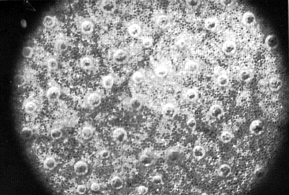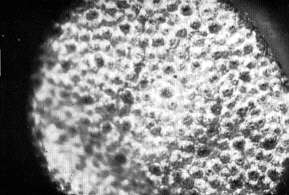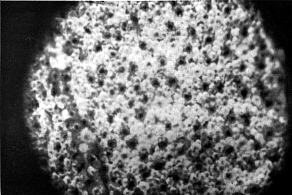QBARS - v15n3 A Study of Rhododendron Scales
A Study of Rhododendron Scales
Bernard M. Swenson, Seattle, Washington
At one of the first meetings of our Seattle Chapter Study Group, a lecture was given on the differences between the R. lapponicum and R. saluenense series. An attempt was made to have everyone see what rhododendron leaf scales looked like through a strong hand glass, but it didn't meet with too much success. After considerable peering and eyestrain, not everyone could actually be sure of what a scale looked like. I then resolved to photograph them as a project for our study group, and some success was had with a borrowed microscope and a few crude parts to adapt the camera to it. The best results have been color transparencies, and I don't feel that the black and white photographs measure up in any way.

|

|
||
|---|---|---|---|
Fig. 36. Scales of R. oreotrephes Seattle Chapter photo |
Fig. 37. Scales of R. hippophaeoides Seattle Chapter photo |
||
|
|||
Our study group had a plant sale last spring to raise money for a new microscope, and it was a smash success with over $500 net profit. We are now the proud owners of a binocular stereoscopic instrument, and in time all members (including myself) could become experts on lepidote rhododendrons.
One of the most interesting and important features used in identifying a rhododendron is the indumentum. This indumentum is made up of leaf appendages called trichomes, namely; scales, hairs and, in rare instances, papillae. No article on rhododendron leaf appendages would be complete without J. M. Cowen's book. "The Rhododendron Leaf," as reference material and a great deal of credit is due him for his work.
This article deals mainly with scales, but before going on to them, it should be mentioned that the thick suede-like indumentum most of us are familiar with is formed by hairs of many kinds. Every degree of density may be found all the way down to discontinuous tufts and scattered hairs. The shiny indumentum seen in the Arboreum series and some of its hybrids is formed by waxy pegs called papillae, but these are seldom seen outside the Arboreum series as thick indumentum.
The function of hairs and papillae is to store water, but scales have the ability to store water in periods of drought, and also the opposite function of expiring moisture in periods of excess water.
Scales have been classified into five types:
- Entire . These could be described as resembling a sunflower, with the petals as the "rayed cells," and the seed section as the "central disc." All entire scales are circular, having an even edge along the outer rim of the rayed cells, and are the most common.
- Crenulate . The rayed cells are very long and funnel shaped, with an uneven rim and a small central disc. These scales sometimes have a long stem.
- Undulate . These scales have a large flat central disc, and uneven rayed cells.
- Lacerate . Lacerate scales have long rayed cells with deeply indented rims that intertwine to form a thick indumentum.
- Vesicular . These scales look perhaps like a small light bulb as they have no rayed cells.
| Series |
Entire
Scales |
Lacerate
Scales |
Crenulate
Scales |
Undulate
Scales |
Vesicular
Scales |
Papillae |
Unicelular
Hairs |
Lori-form
Hairs |
|---|---|---|---|---|---|---|---|---|
anthopogon |
X |
X |
||||||
boothii |
X |
X |
X |
|||||
camelliiflorum |
X |
X |
||||||
campylogynum |
X |
|||||||
carolinianum |
X |
|||||||
cephalanthum |
X |
X |
||||||
cinnabarinum |
X |
X |
||||||
dauricum |
X |
|||||||
edgeworthii |
X |
X |
X |
|||||
ferrugineum |
X |
X |
X |
|||||
glaucophyllum |
X |
X |
X |
|||||
heliolepis |
X |
|||||||
lapponicum |
X |
X |
X |
|||||
lepidotum |
X |
X |
X |
|||||
maddenii |
X |
X |
X |
X |
||||
micranthum |
X |
|||||||
moupinense |
X |
X |
X |
|||||
saluenense |
X |
|||||||
scabrifolium |
X |
X |
X |
X |
||||
trichocladum |
X |
X |
X |
X |
||||
triflorum |
X |
X |
X |
X |
||||
vaccinioides |
X |
|||||||
virgatum |
X |
X |
As you may observe on the chart, some series have more than one type of scale, but one identifying feature of R. glaucophyllum is two colors of scales. It must be stated that the papillae and hairs are not of major importance in identifying lepidote Rhododendrons. Dr. Cowen failed to show it, but I find that at least two species of the Saluenense series have hairs in addition to scales.
The exact function of scales is not entirely clear, but experiments with colored compounds have proved that a scale will absorb moisture and build up a hydrostatic pressure and force it into the circulatory system of the plant. I therefore conclude that when the roots are dry, the scales will pick up moisture from the humid misty air of the high mountains and force it into the plant's circulatory system when its "blood pressure" is down. During rainy periods the scales will act as "perspiration glands" to rid the plant of excess moisture.


